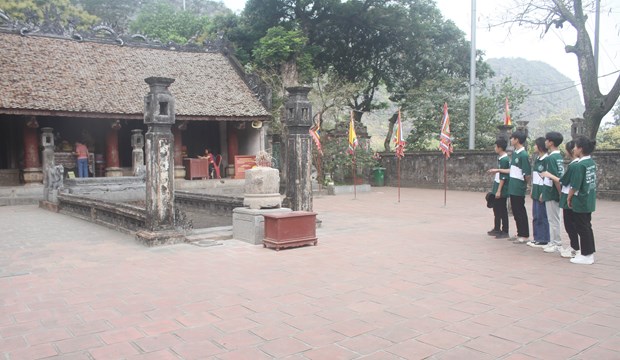Ninh Binh moves to tap tourism potential of historical relics
The northern province of Ninh Binh, home to an array of historical sites, is striving to turn such an advantage into a tourism strength in the time to come.
 A group of students visit the ancient capital of Hoa Lu (Photo: VNA)
A group of students visit the ancient capital of Hoa Lu (Photo: VNA)Located in the southern reaches of the Red River Delta, Ninh Binh is known for its wondrous natural scenery, with a labyrinth of waterways, mountains, and plains as well as cross-cultural influences from the north to the south and from the mountains to the plains and coastal areas. It boasts 1,821 relic areas, including a world cultural and natural heritage site along 81 national relic ones.
According to the provincial Department of Culture and Sports, Ninh Binh has issued a series of guidelines and policies serving sustainable tourism growth, preserving and promoting the value of cultural heritage in association with the development of the sector.
Between 2017 and 2022, the province spent more than 30 billion VND (1.28 million USD) of its budget and over 189 billion VND sourced from public investment on repairing local monuments.
Nguyen Manh Cuong, Director of the department, affirmed that the system of tangible and intangible cultural heritage is now a valuable resource contributing to the attractiveness of Ninh Binh’s image and tourism value. It will serve as a premise for the local tourism to create a breakthrough in the near future, turning out unique products that attract the attention of domestic and foreign tourists, he added.
In the coming time, Ninh Binh plans to focus on promoting the value of heritage sites, cultural traditions, and local life; preserving and renovating relic sites in line with regulations, and developing community-based tourism, among other aspects.
The conservation of the ancient capital of Hoa Lu is a key point in the Resolution of the provincial Party Committee’s standing board regarding tourism development for 2021-2030 with a vision toward 2045.
As one of the four core relic sites in the Trang An Landscape Complex – a UNESCO-recognised World Heritage Site, Hoa Lu is a reminder of a glorious period in the nation's history. It became the capital of Vietnam's first centralised feudal state when Dinh Bo Linh ascended to the throne, taking the name King Dinh Tien Hoang and naming the state Dai Co Viet in 968.
Once covering an area of 300 ha, comprising the Inner, Outer and South Citadels, encircled by defensive earthen walls, Hoa Lu was the capital for 12 years under the Dinh Dynasty (968-980), 29 years under the Early Le (980-1009) and the start of the Ly Dynasty (1009-1010).
The remnants of the ancient capital were found nearly 100km south of Hanoi, in Truong Yen commune, Hoa Lu district. Visitors can combine a trip to Hoa Lu with other famous scenic spots in Ninh Binh, such as the Bai Dinh-Trang An complex, Tam Coc-Bich Dong, Phat Diem stone church or Thung Nham bird park and Van Long wetland reserve.
Le Thi Bich Thuc, deputy director of the centre for Hoa Lu historical and cultural conservation, said that the centre has proactively launched communications campaigns, offered ticket discounts, and established cultural clubs to lure more tourists to the site.
In 2022, Hoa Lu district welcomed 2.4 million visitors and earned more than 1.26 trillion VND from tourism. The locality is expecting the number of tourist arrivals to hit 3.9 million this year./.













